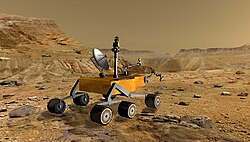PIA16236-MarsCuriosityRover-EtThenRock-20121029
Rock 'Et-Then' Near Curiosity, Sol 82
http://photojournal.jpl.nasa.gov/catalog/PIA16236
The Mars Hand Lens Imager (MAHLI) on the arm of NASA's Mars rover Curiosity took this image of a rock called "Et-Then" during the mission's 82nd sol, or Martian day (Oct. 29, 2012.)
The rock's informal name comes from the name of an island in Great Slave Lake, Northwest Territories, Canada.
MAHLI viewed the rock from a distance of about 15.8 inches (40 centimeters). The image covers an area about 9.5 inches by 7 inches (24 centimeters by 18 centimeters). Et-Then is located near the rover's front left wheel, where the rover has been stationed while scooping soil at the site called "Rocknest."
This is one of three images acquired by MAHLI from slightly different positions so that a three-dimensional information could be used to plan possible future examination of the rock.
Image Credit: NASA/JPL-Caltech/MSSSRelevante Bilder
Relevante Artikel
Mars Science LaboratoryMars Science Laboratory ist eine NASA-Mission im Rahmen des Flagship-Programms, die den Mars hinsichtlich seiner aktuellen und vergangenen Eignung als Biosphäre erforscht. Hierzu wurde auf der Oberfläche ein weitgehend autonomer Rover mit dem Namen Curiosity abgesetzt, der mit zehn Instrumenten zur Untersuchung von Gestein, Atmosphäre und Strahlung ausgerüstet ist. Zu deren Analyse kommen neben einer großen Zahl unterschiedlicher Spektrografen auch Kameras und meteorologische Instrumente zum Einsatz, welche die Messdaten für die Auswertung zur Erde schicken. Mit einer Masse von 900 kg und der Größe eines kompakten Kleinwagens war Curiosity bis zur Landung von Perseverance im Februar 2021 das schwerste von Menschen geschaffene Objekt auf der Marsoberfläche und löste die Viking-Tochtersonden mit je knapp 600 kg ab. .. weiterlesen










































